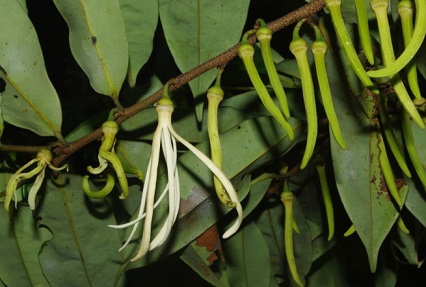Herbs And Phytochemicals: Oxophoebine From Xylopia Aethiopica Can Potentially Inhibit Key Measles Proteins. Further Research Warranted
Nikhil Prasad Fact checked by:Thailand Medical News Team Feb 07, 2024 1 year, 2 months, 1 week, 6 days, 9 hours, 44 minutes ago
Herbs And Phytochemicals: Measles, caused by the Morbillivirus genus, specifically the measles virus (MV), remains a significant global health concern, particularly in developing regions where vaccination coverage may be inadequate. Despite effective vaccines, outbreaks persist, emphasizing the need for complementary anti-measles therapeutics. In this context, Xylopia aethiopica, a medicinal plant with known antiviral properties, commonly known as guinea pepper is explored for its potential in targeting key MV proteins.
 Oxophoebine From Xylopia Aethiopica Can Potentially Inhibit Key Measles Proteins.
Background
Oxophoebine From Xylopia Aethiopica Can Potentially Inhibit Key Measles Proteins.
Background
Measles virus, an enveloped RNA virus, is responsible for severe neurological disorders, making it a major cause of morbidity and mortality, especially among unvaccinated children. While vaccines exist, a 10% failure rate in conferring immunity underscores the necessity for additional anti-measles drugs. This
Herbs And Phytochemicals study focuses on three vital MV proteins: fusion protein (FUP), haemagglutinin protein (HMG), and phosphoprotein (PSP).
Methods
Researchers from Benue State University, University of Ibadan, and Durban University of Technology computationally screened three compounds (vanillin, oxophoebine, and dihydrochalcone) derived from Xylopia aethiopica against these key MV proteins. The investigation utilized advanced molecular dynamics simulations, assessing various postdynamic parameters, including free binding energy and pharmacokinetic properties.
Study Findings
The results indicated that oxophoebine (OPB) exhibited superior docking scores and binding energy values compared to vanillin and dihydrochalcone. Molecular dynamics simulations demonstrated that OPB displayed better poses on MV target proteins, particularly FUP, HMG, and PSP. The study employed techniques such as MM/GBSA, RMSD, RMSF, SASA, and hydrogen bond analysis to explore the stability, flexibility, and interactions of the protein-compound complexes.
OPB emerged as a potential inhibitor of MV glycoproteins (FUP and HMG) and PSP, crucial in MV replication and pathogenesis. The compound demonstrated thermodynamic compactness and stability, suggesting its potential as a scaffold for novel MV fusion and entry inhibitors. The researchers observed that the binding affinity of OPB to FUP, HMG, and PSP was higher than that of the reference standard, ribavirin (RBV), indicating its promising inhibitory properties against these key MV proteins.
Mechanistic Insights
The study delved into the molecular mechanisms underlying OPB's potential inhibitory effects. Specifically, OPB exhibited interactions with essential amino acid residues at the active sites of FUP, HMG, and PSP. This comprehensive analysis shed light on the compound's potential to disrupt the initial conformational changes required for MV infection, making it a promising candidate for further drug development. The identified interactions included C
-H bonds, conventional hydrogen bonds, pi-piT-shaped, van der Waals, amide pi-stacked, pi-cation, pi-anion, pi-sigma, pi-pi-stacked, and attractive charges.
Pharmacokinetic Evaluation
Beyond the molecular dynamics simulations, the study also conducted in silico pharmacokinetic evaluations of the compounds. OPB demonstrated favorable log P values, suggesting good lipid membrane permeability and absorption, essential for oral administration. Additionally, the predicted bioavailability score and blood-brain barrier permeability of OPB indicated its potential as an effective drug candidate for managing MV-induced encephalomyelitis.
The Lipinski's rule of five (Ro5) was employed to assess the physicochemical properties, drug-likeness, and safety properties of the prospective bioactive compounds intended for oral administration. Compounds with log P values greater than 5 may poorly permeate the lipid membrane and not pass through the gut walls, according to Ro5. However, both OPB and RBV showed favorable log P values, ensuring their potential for oral administration.
Furthermore, the researchers explored the bioavailability score, indicating the proportion of a drug dose that remains unchanged and reaches the systemic circulation. Both OPB and RBV demonstrated a good bioavailability score of 0.55, suggesting a high drug concentration needed to elicit maximum therapeutic effects at the site of action. This is a crucial aspect in drug dose calculations, emphasizing the potential of OPB as an effective anti-measles therapeutic.
Conclusion
In conclusion, this research unveils the potential of Xylopia aethiopica compounds, particularly oxophoebine, as anti-measles agents. The study provides a robust computational framework, elucidating the interactions, stability, and pharmacokinetic properties of the compounds. While OPB shows promise as a multifaceted inhibitor of MV, further experimental validation is imperative for its translation into a viable anti-measles therapeutic.
This research not only contributes to the growing body of knowledge regarding natural compounds with antiviral properties but also highlights the potential of computational approaches in drug discovery. The study lays the groundwork for future investigations into natural compounds as potential allies in the ongoing battle against measles and other viral infections. As measles continues to pose a global health threat, the exploration of alternative therapeutics, especially those derived from traditional medicinal plants, becomes crucial in the quest for comprehensive anti-measles strategies. The findings from this study pave the way for continued exploration of Xylopia aethiopica and its compounds, potentially opening new avenues for the development of anti-measles drugs with enhanced efficacy and reduced side effects.
The study findings were published in the peer reviewed journal: Evidence Based Complementary and Alternative Medicine (Hindawi).
https://www.hindawi.com/journals/ecam/2023/1575358/
For the latest on
Herbs And Phytochemicals, keep on logging to Thailand Medical News.
